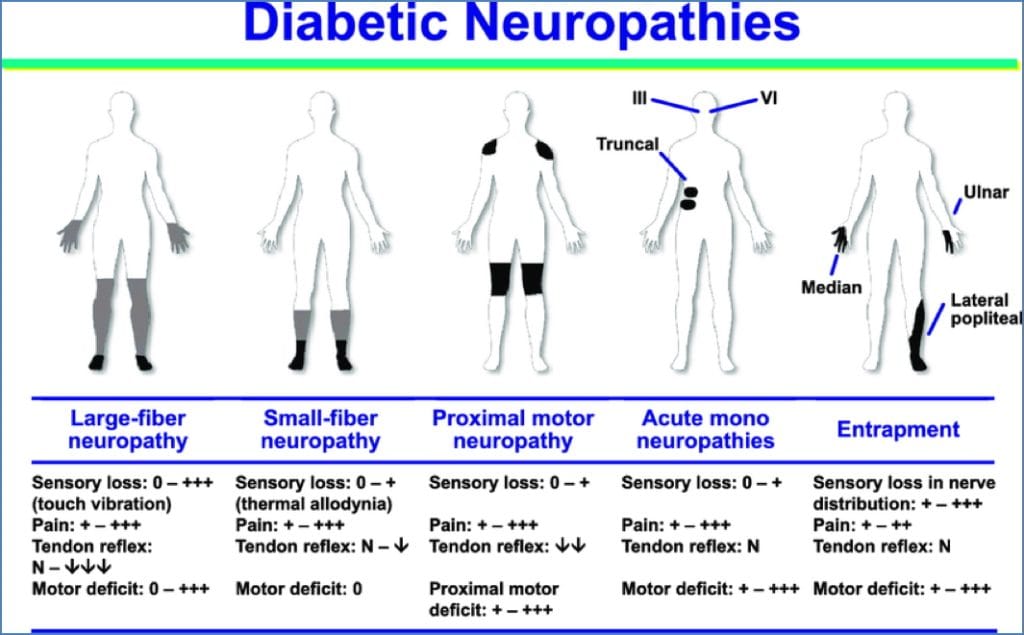Table of Contents
Overview – Peripheral Neuropathies
Peripheral neuropathies are a group of disorders affecting the peripheral nerves, leading to sensory, motor, or autonomic dysfunction. The two most clinically relevant forms in medical practice are diabetic neuropathy and B12 deficiency-related neuropathy. These neuropathies differ in aetiology, pathology, and pattern of nerve involvement but can share overlapping features such as paraesthesia, weakness, and gait instability.
Diabetic Neuropathy
Definition
A chronic, progressive peripheral neuropathy caused by sustained hyperglycaemia, affecting sensory, motor, and autonomic nerves.
Aetiology
- Chronic hyperglycaemia leads to:
- Focal osmotic demyelination of sensory nerves
- Arteriolosclerosis of the vasa nervorum → ischaemic neuropathy
Pathophysiology
- Sensory nerves affected first → they are myelinated
- Hyperglycaemia leads to:
- Myelin sheath damage
- Ischaemia from arteriolar wall thickening
- Impaired axonal transport and neuronal loss
Morphology
- Myelin loss on nerve biopsy (visualised on myelin stains)
- Amyloid-like thickening of basement membranes (arteriolosclerosis)


Clinical Features
Progresses through three stages:
1. Sensory Neuropathy
- Bilateral, symmetrical, distal onset
- “Glove and stocking” paraesthesia, numbness
- Night-time burning pain
- Loss of proprioception → increased risk of ulcers (painless injuries)
2. Motor Neuropathy
- Muscle wasting and weakness
- 3rd nerve palsy (eye down and out ± pupil sparing)
3. Autonomic Neuropathy
- Postural hypotension
- Gastroparesis (nausea, constipation, diarrhoea)
- Bladder dysfunction (retention/incontinence)
- Erectile dysfunction

B12 Deficiency Neuropathy
Definition
A demyelinating neuropathy caused by vitamin B12 deficiency, commonly affecting the spinal cord’s dorsal columns and corticospinal tracts.
Aetiology
- Reduced intake (vegetarian/vegan diets)
- Malabsorption:
- Pernicious anaemia
- GI surgery (e.g. ileal resection)
- Coeliac or Crohn’s disease
- Increased demand or losses
Pathophysiology
- B12 is essential for myelin maintenance and DNA synthesis
- Deficiency leads to:
- Demyelination of posterior columns → sensory loss
- Involvement of corticospinal tracts → weakness
- Axonal oedema and neuronal sclerosis
Morphology
- Demyelination in dorsal columns and lateral corticospinal tracts
- Megaloblastic bone marrow changes
Clinical Features
- Symmetrical weakness and paraesthesia, especially lower limbs
- Loss of vibration and proprioception
- Ataxic gait and positive Romberg sign
- Megaloblastic anaemia (macrocytic RBCs)
- May progress to subacute combined degeneration of the spinal cord if untreated
Management
- Intramuscular or high-dose oral vitamin B12 supplementation

Summary – Peripheral Neuropathies
Peripheral neuropathies are common complications of systemic disease. Diabetic neuropathy presents in a characteristic glove-and-stocking pattern and can progress to motor and autonomic dysfunction. In contrast, B12 deficiency neuropathy preferentially affects posterior column and corticospinal tracts, leading to combined sensory and motor symptoms with anaemia. Early recognition and intervention are critical. For a broader context, see our Nervous System Overview page.